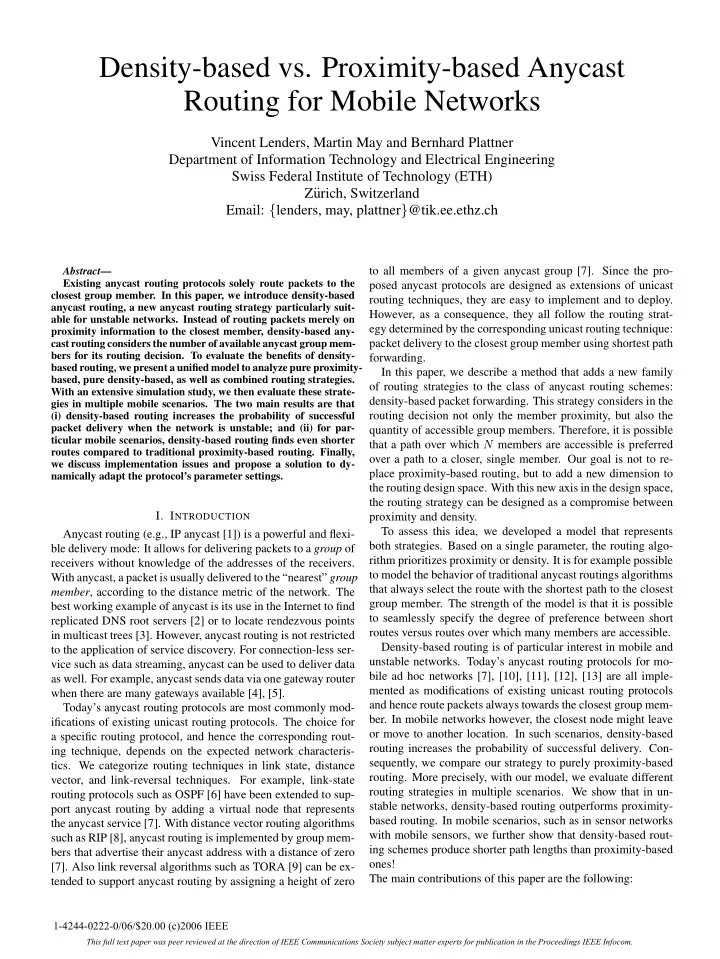

Density-based vs. Proximity-based Anycast Routing for Mobile Networks Vincent Lenders, Martin May and Bernhard Plattner Department of Information Technology and Electrical Engineering Swiss Federal Institute of Technology (ETH) Z¨ urich, Switzerland Email: { lenders, may, plattner } @tik.ee.ethz.ch Abstract — to all members of a given anycast group [7]. Since the pro- Existing anycast routing protocols solely route packets to the posed anycast protocols are designed as extensions of unicast closest group member. In this paper, we introduce density-based routing techniques, they are easy to implement and to deploy. anycast routing, a new anycast routing strategy particularly suit- However, as a consequence, they all follow the routing strat- able for unstable networks. Instead of routing packets merely on egy determined by the corresponding unicast routing technique: proximity information to the closest member, density-based any- packet delivery to the closest group member using shortest path cast routing considers the number of available anycast group mem- bers for its routing decision. To evaluate the benefits of density- forwarding. based routing, we present a unified model to analyze pure proximity- In this paper, we describe a method that adds a new family based, pure density-based, as well as combined routing strategies. of routing strategies to the class of anycast routing schemes: With an extensive simulation study, we then evaluate these strate- density-based packet forwarding. This strategy considers in the gies in multiple mobile scenarios. The two main results are that routing decision not only the member proximity, but also the (i) density-based routing increases the probability of successful packet delivery when the network is unstable; and (ii) for par- quantity of accessible group members. Therefore, it is possible ticular mobile scenarios, density-based routing finds even shorter that a path over which N members are accessible is preferred routes compared to traditional proximity-based routing. Finally, over a path to a closer, single member. Our goal is not to re- we discuss implementation issues and propose a solution to dy- place proximity-based routing, but to add a new dimension to namically adapt the protocol’s parameter settings. the routing design space. With this new axis in the design space, the routing strategy can be designed as a compromise between I. I NTRODUCTION proximity and density. To assess this idea, we developed a model that represents Anycast routing (e.g., IP anycast [1]) is a powerful and flexi- both strategies. Based on a single parameter, the routing algo- ble delivery mode: It allows for delivering packets to a group of rithm prioritizes proximity or density. It is for example possible receivers without knowledge of the addresses of the receivers. to model the behavior of traditional anycast routings algorithms With anycast, a packet is usually delivered to the “nearest” group that always select the route with the shortest path to the closest member , according to the distance metric of the network. The group member. The strength of the model is that it is possible best working example of anycast is its use in the Internet to find to seamlessly specify the degree of preference between short replicated DNS root servers [2] or to locate rendezvous points routes versus routes over which many members are accessible. in multicast trees [3]. However, anycast routing is not restricted Density-based routing is of particular interest in mobile and to the application of service discovery. For connection-less ser- unstable networks. Today’s anycast routing protocols for mo- vice such as data streaming, anycast can be used to deliver data bile ad hoc networks [7], [10], [11], [12], [13] are all imple- as well. For example, anycast sends data via one gateway router mented as modifications of existing unicast routing protocols when there are many gateways available [4], [5]. and hence route packets always towards the closest group mem- Today’s anycast routing protocols are most commonly mod- ber. In mobile networks however, the closest node might leave ifications of existing unicast routing protocols. The choice for or move to another location. In such scenarios, density-based a specific routing protocol, and hence the corresponding rout- routing increases the probability of successful delivery. Con- ing technique, depends on the expected network characteris- sequently, we compare our strategy to purely proximity-based tics. We categorize routing techniques in link state, distance routing. More precisely, with our model, we evaluate different vector, and link-reversal techniques. For example, link-state routing strategies in multiple scenarios. We show that in un- routing protocols such as OSPF [6] have been extended to sup- stable networks, density-based routing outperforms proximity- port anycast routing by adding a virtual node that represents based routing. In mobile scenarios, such as in sensor networks the anycast service [7]. With distance vector routing algorithms with mobile sensors, we further show that density-based rout- such as RIP [8], anycast routing is implemented by group mem- ing schemes produce shorter path lengths than proximity-based bers that advertise their anycast address with a distance of zero ones! [7]. Also link reversal algorithms such as TORA [9] can be ex- The main contributions of this paper are the following: tended to support anycast routing by assigning a height of zero 1-4244-0222-0/06/$20.00 (c)2006 IEEE This full text paper was peer reviewed at the direction of IEEE Communications Society subject matter experts for publication in the Proceedings IEEE Infocom.
Recommend
More recommend